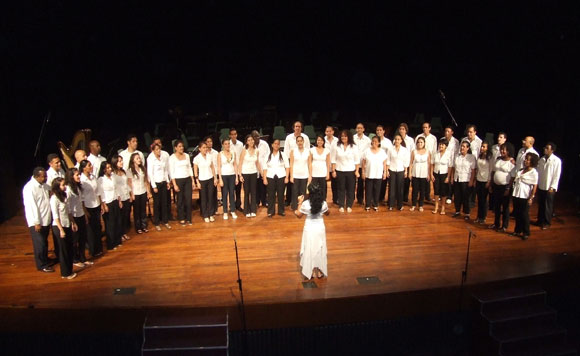11.10.1 National Choir of Cuba.

The Cuban National Choir was created in 1960 by Maestro Serafín Pro. It can be considered a continuation of the Rebel Army Choir, founded in 1959 at the initiative of Commanders Ernesto Guevara and Camilo Cienfuegos, although with quite different characteristics, both in its mixed choir composition and in the works, genres, and styles performed. It was originally named the National Theater Choir (Paseo and 39th Street, Plaza de la Revolución, Havana) and later the Polyphonic Choir, until its designation as the National Choir of Cuba. In 1975, Professor Digna Guerra, a graduate of Choral Conducting from the “Hans Eisler” School of Music in Germany, took over as its director. She has also served as director of the Cuban Institute of Radio and Television Choir (258 23rd Street, Vedado, Plaza de la Revolución, Havana) and of the Cuban National Opera Choir.
Throughout these years of uninterrupted work, the National Choir has carried out intense cultural dissemination of Cuban and world choral music, popular or classical, Renaissance or contemporary. From its earliest years, it began to demonstrate its versatility.
He has performed important premieres and first performances in Cuba of all the aforementioned musical genres. Special mention should be made of Juan Blanco’s “Cantata for Peace” and Borodin’s Polovtsian Dances from Prince Igor with the newly formed National Symphony Orchestra under the direction of Maestro Enrique González Mantici, considered the first symphonic-choral works he performed in his early days. He also participated in the premiere of Mikis Teodorakis’s Canto General, which was brought to Nicaragua. Performances of Beethoven’s Ninth Symphony and Carl Orff’s Carmina Burana have always featured the participation of the National Choir.
He has participated in performances of vernacular theater works such as “La Casita Criolla” and “La Isla de las Cotorras,” alongside the National Opera and Ballet of Cuba. His work emphasizes cultural outreach to the community, and he has given numerous presentations in workplaces, hospitals, and student centers, as well as at facilities dedicated to the defense of our island.
His presence has also been important in the music events organized by UNEAC (Calle 17 No. 354 e/ G and H, Vedado. Plaza de la Revolución. City of Havana), the Contemporary Music Festivals, the International Choir Festivals in Santiago de Cuba, the French Culture Days and cultural galas on the occasion of both national and international events held in Cuba.
He has recorded soundtracks for films such as The Last Supper by Tomás Gutiérrez Alea, with music by Leo Brouwer, and The Age of Enlightenment by Humberto Solás, with music by José María Vitier. He participated in the Cuban premiere of Michel Legrand’s Concert-Oratorio, conducted by Zenaida Romeu and with its composer on piano.
He has conducted choral workshops with important and renowned foreign maestros such as Jeffrey Faiweather of Jamaica; Robert Sund of Sweden; and Jorge Medina of Mexico.








